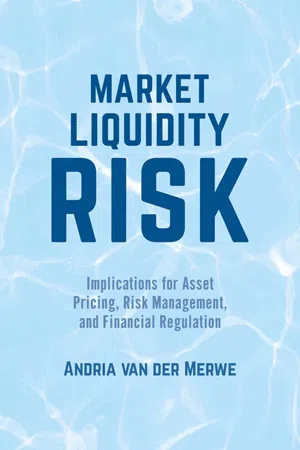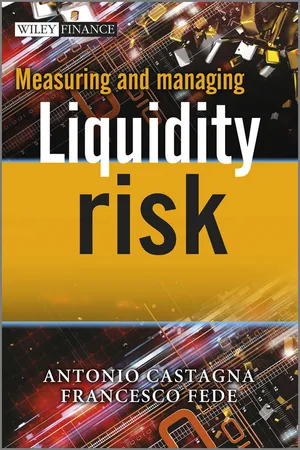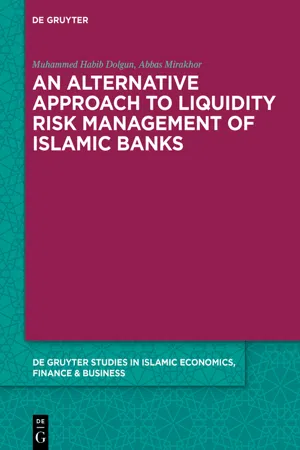Economics
Liquidity Provision
Liquidity provision refers to the process of supplying liquid assets, such as cash or easily tradable securities, to financial markets or institutions. This is done to facilitate smooth and efficient trading and to ensure that there is enough liquidity available to meet the demand for buying and selling assets. By providing liquidity, financial stability and market functioning can be supported.
Written by Perlego with AI-assistance
Related key terms
Related key terms
1 of 4
Related key terms
1 of 3
5 Key excerpts on "Liquidity Provision"
- eBook - ePub
Market Liquidity Risk
Implications for Asset Pricing, Risk Management, and Financial Regulation
- Andria van der Merwe(Author)
- 2016(Publication Date)
- Palgrave Macmillan(Publisher)
1 Musings on LiquidityLiquidity is important and necessary. Liquidity is an assumed characteristic of a well-functioning market, but we only pay attention to it when it is absent—like the proverbial umbrella that is missing when it rains.1 What is market liquidity? Can we measure market liquidity? Can we manage market liquidity?This question seems trivial (or even uninteresting) to the average person who equates liquidity with money in his or her pocket. An economist often associates liquidity with the availability of money or more specifically with the actions of the central bank, succinctly defined by the former chairman of the Federal Reserve, Ben Bernanke, in a 2008 speech on Liquidity Provision by the central bank: “Consistent with its role as the nation’s central bank, the Federal Reserve has responded not only with an easing of monetary policy but also with a number of steps aimed at reducing funding pressures for depository institutions and primary securities dealers and at improving overall market liquidity and market functioning.”2 Traders on the other hand equate liquidity with their ability to buy and sell securities in financial markets.However, none of these broadly defined, superficial understandings of market liquidity were sufficient to prevent the devastating and costly effects of illiquid capital markets we experienced during the 2007–2008 global financial crisis. Subsequent events force us to develop a deeper understanding of market liquidity and beg the question whether the market liquidity paradigm has shifted. Consider, for example, some ad hoc observations on liquidity that were made since the global financial crisis. Regarding the “flash crash” of May 6, 2010, the Economist reported, “This ‘hot potato’ trading generated lots of volume but little net buying. Traditional buyers were unable or unwilling to step in, and the depth of the buying market for e-minis and S&P 500-tracking exchange-traded funds fell to a mere 1% of its level that morning.”3 - eBook - ePub
- Antonio Castagna, Francesco Fede(Authors)
- 2013(Publication Date)
- Wiley(Publisher)
Under normal conditions the central bank should provide a “neutral” amount of liquidity to the financial system to cover its structural liquidity deficit and balance liquidity demand and supply. Banks should receive central bank liquidity and, through interbank and asset markets, should redistribute it within the financial system to liquidity-needing players, who ask for a liquidity amount to satisfy their liquidity constraint. After this redistribution on an aggregate basis, the central bank should calibrate the new liquidity amount to satisfy liquidity demand, and the virtuous circle starts again.In this scenario each liquidity type plays a specific role. Central bank liquidity represents provision of the amount of liquidity to balance aggregate demand and supply. Market liquidity warrants the redistribution and recycling of central bank liquidity among financial agents. Funding liquidity defines the efficient allocation of liquidity resources from the liquidity providers to the liquidity users. As each liquidity type is unique in the financial system, the three liquidity types can only play their specific role by relying on the other two working well and the system overall being liquid. This means that the neutral amount of liquidity provided by the central bank can flow unencumbered among financial agents as long as market liquidity effectively recycles it and funding liquidity allocates it within the system in an efficient and effective way. Markets are liquid because there is enough liquidity in the financial system on aggregate (i.e., there is no aggregate liquidity deficit due to the supply from the central bank) and each counterparty asks for liquidity according to their specific funding needs without hoarding additional Liquidity Provisions. Obviously, funding liquidity depends on the continuous availability of all funding liquidity sources, so a bank is going to be liquid as long as it can get enough liquidity from the interbank market, the asset market or the central bank. These are all preconditions typical of frictionless and efficient markets. In fact, if markets are efficient, banks have recourse to any of the available liquidity options, so the choice will depend only on price considerations. - eBook - ePub
Social Sciences and Interdisciplinary Behavior
The 4th International Congress on Interdisciplinary Behavior and Social Science (ICIBSoS 2015), Kazan Federal University, Kazan, Russia, 22-23 October 2015 & Arya Duta hotel, Jakarta, Indonesia, 07–08 November 2015
- Ford Lumban Gaol, Fonny Hutagalung, Nailya Bagautdinova, Lenar Safiullin(Authors)
- 2016(Publication Date)
- CRC Press(Publisher)
There are three principal ways through which a conventional bank manages its liquidity risk [8]: 1. By holding assets that can be quickly converted into cash. These assets include interest-earning deposits with the central bank, but more importantly they comprise high-quality (to avoid credit risk) short-dated (to avoid market illiquidity and interest rate risk) securities such as short-term obligations issued by government (treasury bills). 2. By structuring its long-term lendings in a manner that allows them to be sold on the secondary market [8,10]. Making its long-term lendings resalable is not a substitute for holding liquidity, but it significantly helps the bank to manage its liquidity position over longer periods. Gradual reductions in the funding available can be managed by selling down some of its long-term lendings, thereby shrinking the total size of the business. 3. Ultimately, the central bank acts as a lender of last resort to the conventional banks that are fundamentally sound but face a sudden and unexpected liquidity outflow.In the conventional banking system with a welldeveloped interbank market, there are a variety of instruments [3] available that the banks can avail of. Frequently, the interbank market works on the basis of unsecured interbank lines for anything from overnight funds to six months, nine months and twelve months after which the market gets very thin. Access to interbank money markets for shortterm borrowings gives considerable flexibility to a bank to adjust its short-term cash flow. Secondary markets in financial instruments have also become an important source for liquidity management, on which banks can rely for managing their liquidity. However, for Islamic banks the instrument has to be asset-based; therefore, it is more closely related to the debt (bond) capital markets.As banking institutions, Islamic banks also have to meet their liquidity needs and obligations to ensure the smooth running of their business, as it is the case with their conventional counterparts [3,5]. However, the very nature of Islamic banks with their objective of avoiding riba in any form has additional issues to address in order to meet their liquidity needs in Sharia complaint manner. Major financial principles of Sharia include a ban on uncertainty (gharar), a ban on interest (riba), a ban on gambling (maysir), adherence to risk-sharing and profit-sharing, promotion of ethical investments that enhance society and do not violate practices banned in the Quran - Muhammed Habib Dolgun, Abbas Mirakhor(Authors)
- 2021(Publication Date)
- De Gruyter Oldenbourg(Publisher)
t means liquid assets. This equation indicates that the LCR needs to be higher than 100% of net cash outflows. For Islamic banks, the right side of the equation should be naturally larger than the left aspect of the equation since Islamic banks take deposits from customers for both investment and saving purposes. Savings accounts are more prone to cash outflows while investment accounts, theoretically, should be stable. For this reason, the 100% level of the LCR requirement may not be appropriate for Islamic banks.2.5 Liquidity Types
Liquidity can be defined as the ease of converting assets to cash or the equivalent. Cash, central bank reserves, and bank reserves are considered as liquid assets. IMF (2015b) defines market liquidity as the ability to rapidly execute sizeable securities transactions at a low cost and with a limited price impact. The Basel Banking Committee contemplates instruments as liquid if they can be converted into cash with maximum 10% loss.There are three kinds of liquidity: funding, monetary and market liquidity (Yildirim, 2009 ; Kerry, 2008 ). Funding liquidity refers to the bank’s ability to mobilize from its interbank or deposit base easily. Monetary liquidity is related to monetary policy and shows the stance of monetary conditions. Market liquidity is related to market conditions – the illiquidity of the market reduces the efficiency in the intermediation costs and can potentially inhibit economic growth (Kerry, 2008 ). Market liquidity can be fragile, that is, prone to evaporation in response to shocks. It is expected that if there are efficient and transparent market infrastructure, market liquidity will be high, which will result in low transactions costs. The asset side of the balance sheet is related to the market liquidity, and the liability side of the balance sheet is related to the funding liquidity risk (Brunnermeier and Pedersen, 2008 ). Theory suggests that market liquidity can affect funding liquidity in stabilising and destabilising manners (Boudt et al., 2013 ). Liquidity contagion across markets can occur, and regulations may decrease market liquidity. Tightening of monetary conditions might affect market liquidity as well as funding liquidity. In general, liquidity risk is considered as a determinant of other risks, such as credit risk (Bissoondoyal and Treepongkaruna, 2011 ) or a determinant of bank performance (Arif and Anees, 2012 ).16- eBook - ePub
Value-Based Working Capital Management
Determining Liquid Asset Levels in Entrepreneurial Environments
- G. Michalski(Author)
- 2014(Publication Date)
- Palgrave Macmillan(Publisher)
Similarly, a shortage of enterprise liquidity is associated with insufficient resources and/or proceeds. They are not enough to make all the necessary purchases and to settle all commitments. Both phenomena—liquidity deficiency and excess—are normal, if they last for a short time. Liquidity can be considered as a micro- or macro-scale phenomenon. Financial enterprise liquidity in macro-economic terms affects the situation of enterprises in an indirect way, determining the price at which it is possible to obtain external financing or make financial investment if the enterprise generates a surplus (Michalski 2010; Michalski 2008). A lack of financial liquidity occurring simultaneously in a number of business entities makes them demand external financing, resulting in an increase in the market cost of the financing. A general lack of liquidity in the macro scale, due to the particular monetary policy of a state, works similarly (Preve and Sarria-Allende 2010; Samuels, Wilkers, and Brayshaw 1993; Singh 2008). When there is less of a commodity than needed, it becomes relatively more valuable. The financial liquidity of an enterprise can also be considered from the long- or short-term perspective. The definition that specifies liquidity as “the ability to make purchases when they are needed and the ability to pay financial obligations in due time” refers to the short-term meaning of liquidity. Long-term liquidity is also referred to as “the income balance.” It occurs when an enterprise has the ability to make purchases and the ability to settle financial liabilities, which means this is a situation in which the monetary income of the entity substantially outweighs the total cash requirements, but it is not necessarily a guarantee of the existence of liquidity in the short term; that is, from the point of view of long-term liquidity, it is not necessary that the money is available at any time (Michalski 2010; Weston 1963; Varian 1987)
Index pages curate the most relevant extracts from our library of academic textbooks. They’ve been created using an in-house natural language model (NLM), each adding context and meaning to key research topics.
Explore more topic indexes
Explore more topic indexes
1 of 6
Explore more topic indexes
1 of 4




